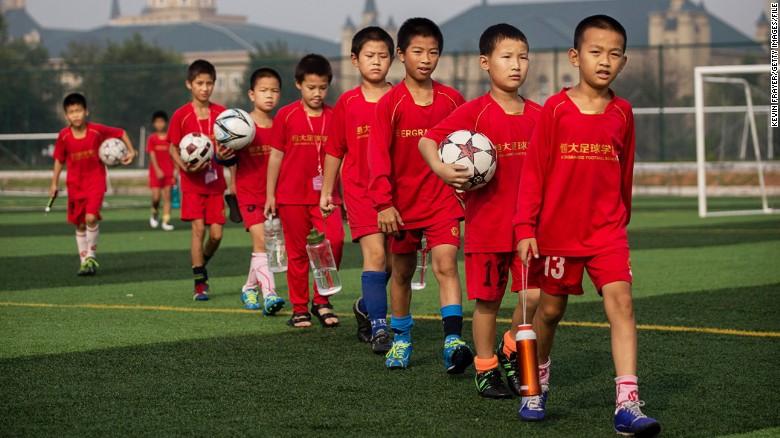“Exploring the World of Soccer in China
Related Articles Exploring the World of Soccer in China
Exploring the World of Soccer in China

Soccer, or football as it’s known to most of the world, is the most popular sport on the planet. It boasts billions of fans, transcends cultural barriers, and ignites passions like few other activities can. While traditionally dominated by European and South American powerhouses, the beautiful game has been steadily gaining traction in China, a nation with aspirations of becoming a major player on the global soccer stage. This article delves into the multifaceted world of soccer in China, exploring its history, current state, challenges, and future prospects.
A History of Kicking Around: Soccer’s Roots in China
The history of soccer in China is surprisingly long, stretching back over two millennia. The ancient game of cuju (蹴鞠), which involved kicking a leather ball through a net strung between bamboo canes, is widely considered to be the earliest form of football. Evidence suggests that cuju was played as early as the 3rd century BC during the Han Dynasty, and it served as both a military training exercise and a form of entertainment.
Over the centuries, cuju evolved and spread throughout China. During the Tang Dynasty (618-907 AD), it became a popular pastime among the imperial court, with elaborate rules and regulations. Women also participated in cuju, and professional teams emerged. However, the game’s popularity waned during the Ming Dynasty (1368-1644), and it gradually faded into obscurity.
Modern soccer was introduced to China in the late 19th century by British missionaries and traders. It quickly gained popularity among students and intellectuals, and the first Chinese soccer teams were formed in the early 20th century. China joined FIFA in 1931 and participated in the 1936 Summer Olympics in Berlin.
The Rise and Fall and Rise Again: A Rollercoaster Ride
The development of soccer in China has been a rollercoaster ride, marked by periods of rapid growth followed by periods of stagnation and decline. In the early decades of the People’s Republic of China, soccer was promoted as a tool for national unity and physical fitness. The national team achieved some success, finishing as runners-up in the 1984 Asian Cup.
However, the sport suffered a setback in the 1990s due to corruption, match-fixing, and a lack of investment in youth development. Attendance at domestic league matches plummeted, and the national team struggled to qualify for major international tournaments.
In the early 2000s, efforts were made to clean up the sport and revitalize the domestic league. The Chinese Super League (CSL) was established in 2004, and foreign players and coaches were brought in to raise the level of play. This injection of talent helped to increase the league’s popularity and attract more investment.
The Xi Jinping Effect: A National Passion Rekindled
The current surge in interest and investment in soccer in China can be largely attributed to President Xi Jinping, a self-confessed soccer fan. Xi has made it clear that he wants China to become a soccer superpower, and he has launched a series of initiatives to achieve this goal.
These initiatives include:
- Investing heavily in youth development: The government has invested billions of dollars in building new soccer academies and training facilities across the country. The goal is to identify and develop young talent who can compete at the highest level.
- Reforming the domestic league: The CSL has been reformed to make it more competitive and attractive to fans. Regulations have been introduced to limit the number of foreign players on each team and to encourage clubs to invest in Chinese players.
- Promoting soccer in schools: Soccer has been made a compulsory part of the curriculum in many schools, and efforts are being made to train more soccer coaches and teachers.
- Hosting major international tournaments: China has expressed its interest in hosting the FIFA World Cup in the future. Hosting such a prestigious event would help to raise the profile of soccer in the country and inspire a new generation of players and fans.

The Chinese Super League: A League of Ambition and Controversy
The Chinese Super League (CSL) is the top tier of professional soccer in China. It has attracted significant investment in recent years, and many high-profile foreign players and coaches have joined the league. The CSL has become known for its high spending and its ambition to become one of the world’s leading soccer leagues.
However, the CSL has also faced criticism for its reliance on foreign players and its lack of focus on developing domestic talent. Some observers argue that the league’s spending is unsustainable and that it is not doing enough to promote the long-term growth of soccer in China.
Challenges and Obstacles: A Long Road Ahead
Despite the progress that has been made in recent years, soccer in China still faces a number of challenges and obstacles. These include:
- Corruption and match-fixing: Although efforts have been made to clean up the sport, corruption and match-fixing remain a problem in Chinese soccer. This undermines the integrity of the game and discourages fans from supporting it.
- Lack of grassroots development: While investment in youth academies is increasing, there is still a lack of grassroots development in many parts of the country. This means that many talented young players are not getting the opportunity to develop their skills.
- Limited infrastructure: China lacks the infrastructure needed to support a thriving soccer culture. There are not enough soccer fields, training facilities, and qualified coaches.
- Cultural barriers: Soccer is not as deeply ingrained in Chinese culture as it is in Europe and South America. This means that it can be difficult to attract and retain fans.
The Future of Soccer in China: A Promising Outlook
Despite the challenges, the future of soccer in China looks promising. The government’s commitment to developing the sport, the increasing investment in youth development, and the growing popularity of the CSL all suggest that soccer will continue to grow in China in the years to come.
However, China needs to address the challenges it faces if it wants to achieve its goal of becoming a soccer superpower. This will require a long-term commitment to developing domestic talent, cleaning up corruption, and investing in infrastructure.
Beyond the Pitch: The Societal Impact
The rise of soccer in China is not just about sports; it also has a significant societal impact. It fosters national pride and unity, promotes a healthy lifestyle, and provides opportunities for young people to develop their skills and pursue their dreams. Soccer also serves as a bridge between China and the rest of the world, promoting cultural exchange and understanding.
Conclusion: A Nation’s Soccer Dream
The journey of soccer in China is a complex and fascinating one. From its ancient roots in cuju to its modern-day aspirations of becoming a global powerhouse, soccer has played a significant role in Chinese history and culture. While challenges remain, the current momentum and the unwavering support from the government and the people suggest that China is on the right track to achieving its soccer dream. The world will be watching to see if China can truly become a major player in the beautiful game. The potential is there; now it’s a matter of execution, patience, and a continued passion for the sport. The future of soccer in China is, without a doubt, one to watch closely.

